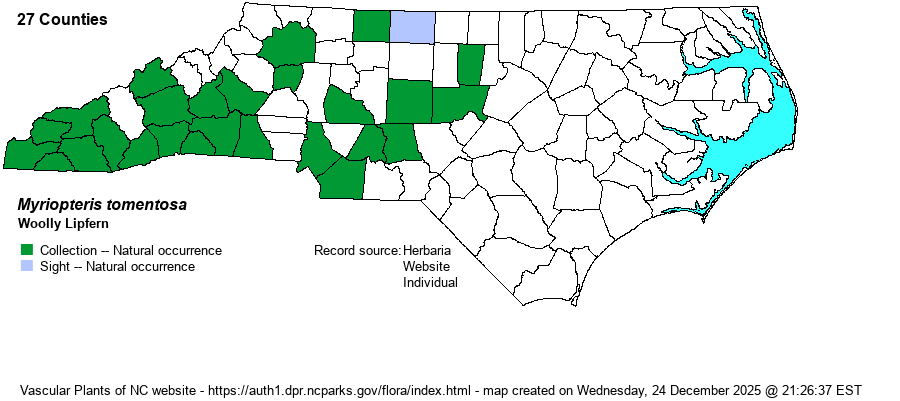| Section 2 » Family Pteridaceae |
Show/Hide Synonym
| taxonName | relationship | relatedTaxonName | relatedTaxonRefText | relComments |
|---|
|
| Myriopteris tomentosa | = | Cheilanthes tomentosa | | | | Myriopteris tomentosa | = | Cheilanthes tomentosa | Gleason and Cronquist (1991) | | | Myriopteris tomentosa | = | Cheilanthes tomentosa | Flora of North America (1993b, 1997, 2000, 2002a, 2002b, 2003a, 2004b, 2005, 2006a, 2006b, 2006c, 2007a, 2009, 2010) | | | Myriopteris tomentosa | = | Cheilanthes tomentosa | Gleason (1952) | | | Myriopteris tomentosa | = | Cheilanthes tomentosa | Kartesz (1999) | | | Myriopteris tomentosa | = | Cheilanthes tomentosa | Radford, Ahles, and Bell (1968) | | | Myriopteris tomentosa | = | Cheilanthes tomentosa | | | | Myriopteris tomentosa | = | Cheilanthes tomentosa | Flora of Virginia | | | Myriopteris tomentosa | = | Cheilanthes tomentosa | Wofford (1989) | | | Myriopteris tomentosa | = | Cheilanthes tomentosa | Small (1933, 1938) | | | Myriopteris tomentosa | = | Cheilanthes tomentosa | Gastony & Rollo (1998). [also see Argyrochosma and Astrolepis] | | | Myriopteris tomentosa | = | Cheilanthes lanosa | Fernald (1950) | , misapplied | | Source: Weakley's Flora |
|
| Author | (Link) Fee | |
| Distribution | Scattered over most of the Mountains and Piedmont, though absent from the northeastern Piedmont. Does not range into the Coastal Plain.
This Southern species ranges north to WV, northern VA, and southeastern KS, south to southern GA and AZ, being essentially absent from the Coastal Plain. Also in Mex. | |
| Abundance | Uncommon to locally infrequent in the Mountains, and quite uncommon in the Piedmont; apparently absent east of Rockingham, Orange, and Chatham counties. | |
| Habitat | This is a rock-inhabiting species, on many rock types. It favors somewhat circumneutral to slightly acidic soils, often on calcareous or mafic rocks, but scarce around more felsic rocks such as granite. It grows in rock crevices where the soil is dry and rather exposed; in dry weather the plants can look quite stressed. |
| Phenology | Fruits from June to September. | |
| Identification | True to its Latin and common names, this is a woolly-looking species, with a glaucous, pale whitish-gray-green blade. The stipes are very hairy and scaly, about 3-4 inches long, shorter than the blade, which averages about 6-7 inches long and about 2.5 inches wide. The blade is tripinnate, with about 15-25 pairs of pinnae. This species and the others in the genus have sori in rows or lines, along the margins of the pinnules on the underside of the blade. The pinnule margins are strongly rolled-under such that the sori are usually hidden from view, as seen from below. M. lanosa often grows with this species, but that species has the blades green above and less hairy, only hairs on the stipe and rachis as opposed to hairs and scales in M. tomentosa. In addition, that species has the pinnules curled under but an observer should still easily see the sori. | |
| Taxonomic Comments | This and other NC species were formerly in the genus Cheilanthes.
| |
| Other Common Name(s) | None | |
| State Rank | S3 | |
| Global Rank | G5 | |
| State Status | | |
| US Status | | |
| USACE-agcp | | |
| USACE-emp | | |

